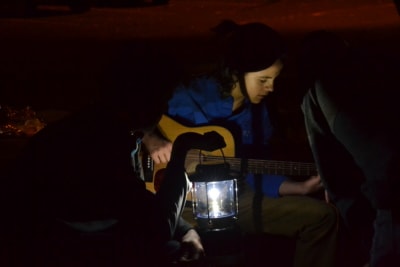Last Wednesday, the Intentional Death Prevention Committee, a committee of the Child Fatality Task Force, approved several suicide prevention recommendations that, if made into law, would make major changes to how state schools approach suicide.
As part of EducationNC’s five-part series in October on youth suicide in NC, reporter Adam Rhew pointed out several deficiencies in student support in the state’s schools.
When it comes to school counselors, social workers, psychologists, and nurses, North Carolina is well below the nationally-recommended ratios. A work group that came up with the recommendations passed last week confronted these gaps and other suicide-related issues. The work group was made up of public and private sector experts, and presented four recommendations:
1. Legislatively require suicide prevention training for all school personnel that directly interacts with students, a school process for implementation of that training, and a school risk referral protocol that is communicated to students and families.
The mandatory training would consist of a two-hour online module created by the Department of Public Instruction (DPI). The framework for the training already exists and the current module is being modified and shortened.
During the discussion of this recommendation, DPI staff — the director of Safe and Healthy Schools Support Ben Matthews and NC Healthy Schools section chief Ellen Essick — were asked if their department had the capacity to implement the training without an additional position, included in recommendation 3.
They replied that they could push the training out and document which schools have and haven’t completed the training, but additional staff and funding would be extremely helpful.
“We have the capability of getting this out to all school personnel,” Essick said. “We have the capability of asking if they have participated. We don’t have the ability to monitor and follow up, and do anything if they haven’t,” she said. “If folks identify a need after this, then we are at a place where we don’t have the skill sets to provide (assistance).”
Local school districts and charter schools can use their own training instead of the module, but must include certain components: data-based rationale for the training, myths and attitudes surrounding suicide, identification of at-risk students, steps to take for referral, and others.
Other than the training, schools would need a protocol policy. They are able to use resources and policies created by DPI in consultation with the Department of Health and Human Services, or create their own protocol.
Either way, necessary components of the school’s protocol must include a plan for mandatory prevention training, a plan to ensure more specialized training for student-support personnel like counselors and nurses, a safety plan for schools if an at-risk child is identified or in the event of a suicide death or suicide attempt by a student, and more.
Schools have to report their compliance with training and protocol requirements once a year. The goal is to have this recommendation in place by January 2018.
2. Increase funding to the School Nurse Funding Initiative by $5 million in recurring funds to add 50 school nurses in high-need communities.
This recommendation is an attempt to work towards meeting the national standards for student-service staff members. The nationally-recommended ratio of school nurses to students is 1:750. In North Carolina, the ratio for 2015-16 was 1:1086, according to a handout from the work group that presented to the Committee. Only 46 out of 115 school districts meet the recommended ratio, and the state would need 592 additional nurses to fully meet the standard.
The placement of these 50 nurses would be determined by a school’s current nurse-to-school ratio, the economic status of the community, and the health and academic needs of students. Senator Don Davis, D-Greene had concerns over defining “high-need” and targeting the correct school districts.
“How well do we know that that’s prevalent in those highest need communities?” Davis said. “And it may be that you have some outliers that would be identified through the data as a high-need area that wouldn’t necessarily fit into the parameters,” he said.
The committee added an amendment to take a look at the data that each school district collects from reports by school nurses who work with students that have suicidal ideation or have attempted suicide.
3. Appropriate $200,000 in recurring funds for a full-time school social worker consultant, housed in the Department of Public Instruction (DPI) Student Support Services, to provide coordination, training, support, and data collection for the state’s school social workers.
According to the working group’s handout, there is currently no state level position at DPI devoted to school social workers — which makes it extremely difficult to coordinate training, provide technical support or collect data related to outcomes. There is already a similar position for school nurses, psychologists, and counselors.
“We also know that these are critical positions in suicide prevention,” said Sarah Vidrine, a senior policy analyst at NC Child. “School social workers see some of the kids at highest-risk of suicide and also have the ability to work with the whole family system, including the ability to do home visits.”
4. Designate and fund a three-year lead suicide prevention position that would coordinate cross-agency efforts to carry out implementation of the 2015 NC Suicide Prevention Strategic Plan and determine a sustainability plan for ongoing statewide coordination for implementation of the strategic plan. An appropriation between $250,000 and $280,000 is needed per year for 2 years, and between $125,000 and $140,000 will be needed for a third year.
This position could be filled by an individual and/or an organization and would be responsible for helping all the players work together — the nonprofits, government agencies, and academic institutions working on suicide prevention.
Organizations discussed by the group include the UNC Injury Prevention Research Center, the Duke Center for the Study of Suicide Prevention and Intervention, and the Health and Medicine Division, formerly known as the Institute of Medicine.
The lead individual would be required to have an M.D. or Ph.D., specific expertise in suicide prevention, and affiliation with an organization able to provide management and administrative support.
The position would be funded for three years, but the individual or organization is expected to find a sustainable method and funding for future statewide coordination.
The Intentional Death Committee’s approval was just the first step towards presenting the recommendations to the Governor and General Assembly. The recommendations will go in front of the full Child Fatality Task Force — made up of state senators, representatives and others — at their next meeting, which is scheduled for December 12.



